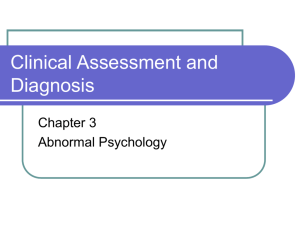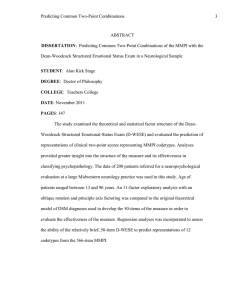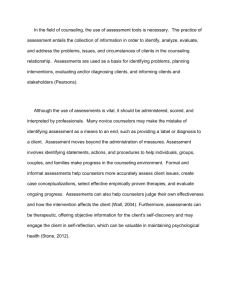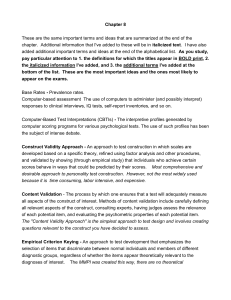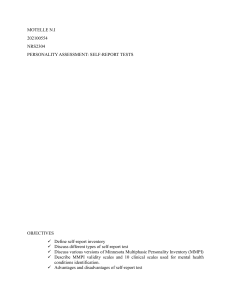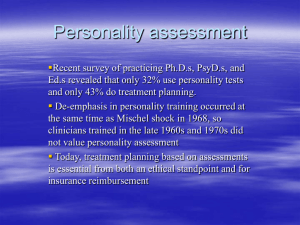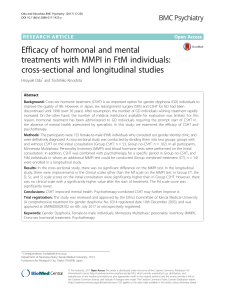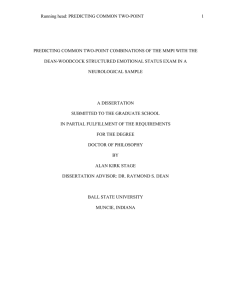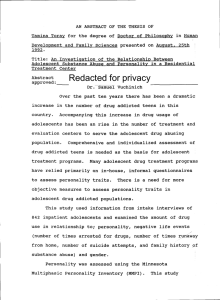There are many methods when it comes to a
advertisement
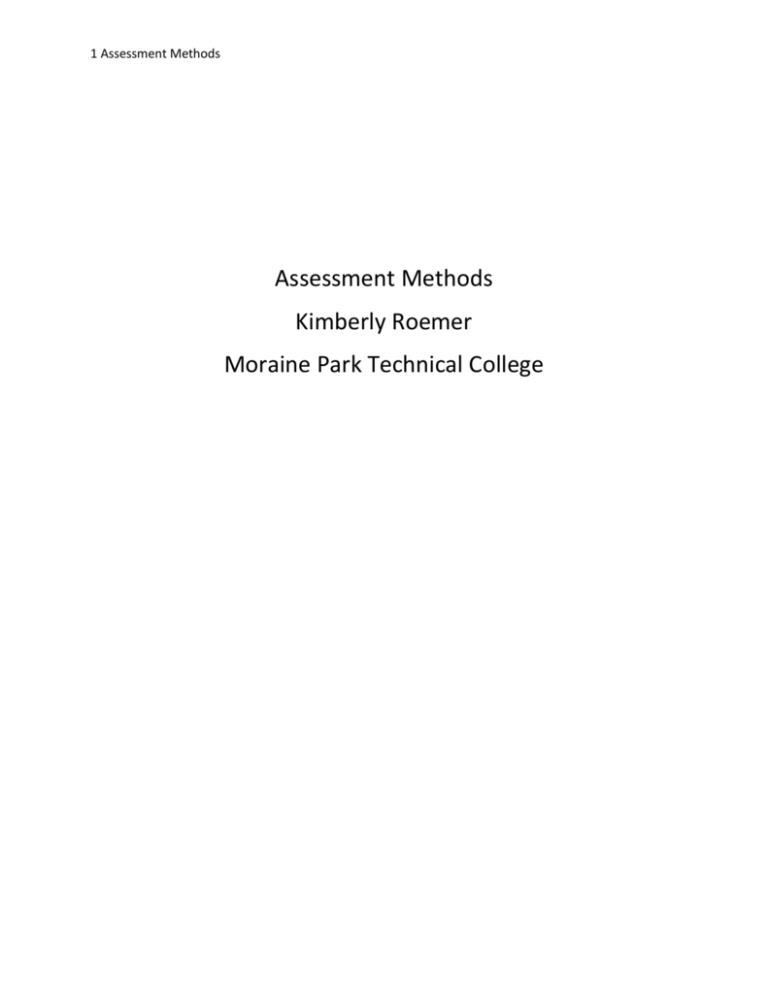
1 Assessment Methods Assessment Methods Kimberly Roemer Moraine Park Technical College 2 Assessment Methods There are many methods when it comes to a clinical assessment, in the AODA field. The assessment is important, when diagnosing and planning treatment for the client. The clinical assessment helps the clinician determine how the client sees their situation. Not every test works for every client, so proper training is required, in order to determine which test is the correct one, and how to read these tests. There are three different types of assessments. There are neurological and biological tests, clinical interviews and intelligence tests. The MMPI (Minnesota Multiphasic Personality Inventory), is one. It is a true/false questionnaire, to determine personality, behaviors, thoughts, and feelings (Seligman, 2001). The CPI was developed to focus on more acute personality traits. The SCL-90-R, focuses on psychopathology, rather than personality. Other tests include the Rorschach test, which works with ink blots, the TAT, which consists of a series of pictures, and also intelligence tests. Each test is meant to explain something different in the client (Seligman, 2001). The MMPI was developed at the University of Minnesota Hospital on patients, and on their relatives and visitors. Developers considered the non-patients to be comparable to the adult population of Minnesota in the 1930s: between the ages of 16 and 65, mainly married, living in small towns and rural areas, with an eighth-grade education level. Starke R. Hathaway, a clinical psychologist, and J. Charnley McKinley, a neuropsychiatrist, started work on the test during the late 1930s. A pool of over 1,000 potential items to use in the inventory were developed, but after elimination of similar or poorly worded statements, the item list was reduced to 504. Each of the statements was also reworded to avoid the impression of a formal examination or interrogation. 3 Assessment Methods There are different tests for different age groups. The MMPI-2, is for adults and the MMPI-A is for adolescents ages 14-18. The MMPI was originally developed because of the lack of screening in mental health hospitals. The tests were used on a control group of “normal” people and patients in treatment, in order to determine its validity. The test has been revised over time, to improve the scientific-psychometric adequacy. (Austin, 1994). One issue with the test is, there is not enough adequate information in the test to deal with Asian and Hispanic norms. Another issue is, an over-representation of higher educational and occupational groups in the national normative sample (Austin, 1994). There is a very wide array of questions on the MMPI, from the most basic questions, to some that are quite different. “I have sometimes felt that difficulties were piling up so high that I could not overcome them.” “At times I feel like smashing things.” “I like to know some important people because it makes me feel important.” “At one or more times I have felt that someone was trying to make me do things by hypnotizing me.” “Everything tastes the same.” (Cloak, 1997). The MMPI determines 10 different dimensions of personality and psychopathology. The MMPI has been found to be a very accurate measure, and is very reliable in conducting results among clients. It is possible; however, that a patient can lie on the test, so make them not look like something is wrong with them. There are four validity scales, that are designed to alert the diagnostician to such distortions (Seligman, 2001). The MMPI is the most widely used test in the psychiatric field. It is also used in legal cases, and cases of custody disputes. This test is also used, at times, to screen potential candidates for 4 Assessment Methods high stress jobs. The MMPI-2 has 567 questions on it, and takes 60-90 minutes to complete. The MMPI-2-RF contains 338 questions and takes around 30 to 50 minutes to complete. As with all psychological tests, there should be other tests given, along with the diagnosis; for accuracy. There are 10 scales of the MMPI. The first is, Hypochondriasis, to check personal well-being. The second is, depression, and the third is, hysteria. The fourth is, Psychopathic Deviate, which helps identify potential psychopaths. Number 5 is, Masculinity/Femininity, which originally tested for homosexual tendencies, but now tests for intelligence and education. Scale 6 is, paranoia, scale 7 is, Psychasthenia, which is now diagnosed as OCD. Scale 8 is, Schizophrenia, scale 9 is, Hypomania, which means depression, accelerated speech, and elevated mood. Scale 10 is, introversion. There are also validity scales to the MMPI. The L scale, determines if the client is lying about being good or bad. The K scale is a way to measure if the client is trying to make themselves seen in a better light, than they really are. The ? scale means when the client leaves more than 30 questions un-answered, the test is deemed invalid. TRIN Scale, The True Response Inconsistency Scale was developed to detect patients who respond inconsistently. This section consists of 23 paired questions that are opposite of each other. All of the psychological tests help determine the diagnosis for the client. Some appear to be more valid and more widely used than others. It is detrimental, that for all testing, the clinician is trained to give these tests and to read these tests, so a proper diagnosis can be given. 5 Assessment Methods References Austin, J. T. (1994). Minnesota Multiphasic Personality Inventory (MMPI-2). Measurement & Evaluation In Counseling & Development. American Counseling Association, 27(3), 178. Cloak, N. L. (1997). Factor analysis of Minnesota Multiphasic Personality Inventory-1 (MMPI-1) validity scale items. Measurement & Evaluation In Counseling & Development (American Counseling Association), , 30(1), 40. Seligman, M. E. (2001). Abnormal Psychology. W. W. Norton and Company. Wise, E. A. (2010). A Review and Comparison of the Reliabilities of the MMPI-2, MCMI-III, and PAI Presented in Their Respective Test Manuals. Measurement & Evaluation In Counseling & Development (Sage Publications Inc. ), , 42(4), 246. doi:10.1177/0748175609354594.


